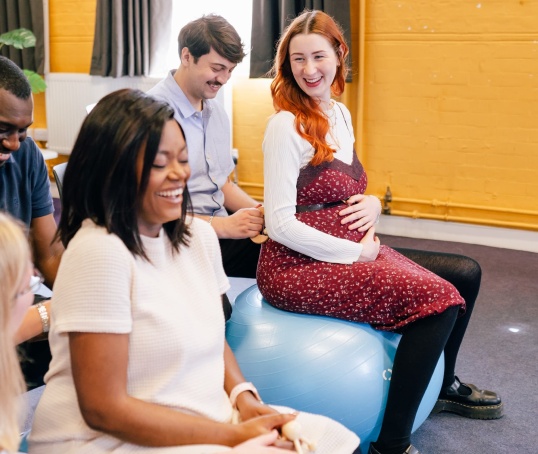Find out about the different options available for pain relief in labour and childbirth, including epidural, pethidine, TENS and other ways to reduce pain.
In this article:
- Overcoming fear during labour
- Position and movement in labour
- Water and birthing pools in labour
- TENS (Transcutaneous Electrical Nerve Stimulation) machine in labour
- Complementary therapies
- Sterile water injections
- Gas and air (Entonox) in labour
- Painkilling drugs in labour (opioids such as pethidine, diamorphine, meptid and remifentanil)
- Epidural
- Top tips for labour
- Do what feels best for you
- Further information
When it comes to giving birth, most women want to know: how much is it going to hurt and will I be able to cope with the pain? Unfortunately, you can’t answer either of these questions with certainty. But what you can do is improve your ability to cope with pain during labour, as well as understand your options for pain relief and their impact on you, your labour and baby.
Your birth partner(s) will make a huge difference to how you feel during labour. Emotional support, such as encouragement and reassurance from somebody you trust, can really boost your confidence and ability to cope with pain when you need it most.
Here we look at the different pain relief options that are available during labour.
Overcoming fear during labour
Labour is complex but, unfortunately, fear can affect this amazing process.
Fear makes you release adrenaline, which slows down the production of oxytocin and prepares your body to fight or run away (not helpful when you’re trying to give birth). This makes your contractions less efficient and you focus on the pain and feel worse. So staying calm is the key to coping with pain.
To help you feel relaxed, it's good to read up on what happens during labour and choose a place to give birth where you feel safe.
It'll help to choose the right person to be your birth partner to help you cope with the pain and discomfort of labour more easily. It should be a person you trust, and who can give you encouragement, reassurance, listen to you and just be there. Research has shown that emotional support is important for women in labour.
Attending antenatal classes is also a really useful way of preparing for labour and gaining an understanding of what will happen on the day.
If it feels really tough, ask your midwife how you are getting on. Positive encouragement – knowing you are coping really well and making good progress – can make all the difference.
Position and movement in labour
Labour can last a long time so, at the beginning, try movement, upright positions, massage and water to help you cope. If you head straight for maximum pain relief, you’ll never know how other things can help – plus your labour may end up being even longer.
Lying on your back can make your contractions slower and more painful. Different positions and movement, such as rocking, swaying and leaning forwards, maximises your body’s ability to give birth as it helps ease your baby along the birth canal.
Pros
- Maximises your body’s ability to give birth.
- No lasting side-effects for you or your baby
Cons
- Try not to overdo it; saving energy is also important. Lying on your side for a while or sitting up supported by lots of pillows can help your body to work really well while you conserve energy.
Water and birthing pools in labour
Water soothes pain and, in a large birthing pool, supports you, enabling you to glide into any position. For more about water births and using water during labour, see here.
TENS (Transcutaneous Electrical Nerve Stimulation) machine in labour
A TENS machine transmits mild electrical impulses to pads on your back. These block pain signals and help your body to produce endorphins. For more about the pros and cons of TENS, see here.
Complementary therapies
Various complementary therapies are available, such as acupuncture, aromatherapy, reflexology, yoga, self-hypnosis and massage.
Pros
- Some studies show acupuncture is helpful.
- Massage or pressure on the lower part of your back can help reduce levels of stress and ease discomfort, too.
- You can learn self-hypnosis techniques for labour by attending a course or using CDs; you don’t have to have a hypnotherapist with you in labour.
Cons
- There is little research proving the effectiveness of these treatments though lots of women say that they found these techniques useful.
- Apart from massage and self-hypnosis, you will need a registered practitioner to perform the therapies.
Sterile water injections
Sterile water injections involve injecting a tiny bit of water into the skin of your lower back to help with back pain during labour. For more about sterile water injections, see here.
Gas and air (Entonox) in labour
Entonox is a colourless, odourless gas made up of half nitrous oxide and half oxygen. You'll probably be given gas and air through a mouthpiece and told how to breathe it in. Read more about Entonox here.
Painkilling drugs in labour (opioids such as pethidine, diamorphine, meptid and remifentanil)
Pethidine, diamorphine and meptid are pain relieving drugs given by injection into the thigh. Some hospitals offer remifentanil, which is a very strong, short-acting painkiller given via a drip that you can control yourself using a machine. For more details, see our articles about intramuscular opioids and remifentanil.
Epidural
Epidural analgesia is a local anaesthetic injected into the space between two vertebra in your back. It usually removes all pain and most feeling from the waist down.
The combined spinal epidural (CSE) injection contains a low dose of pain-relieving drugs and works more quickly than an epidural alone. Read more about their pros and cons in our articles about epidurals and CSEs.
Top tips for labour
The following tips have been found to be useful by women in labour:
- Before labour, spend some time imagining having your new baby in your arms after the birth and that all is well. Imagining that you did it, and that you did it as you wanted, creates a positive picture to focus on.
- Moving about helps labour to progress and women have said they were better able to work with the pain while rocking and leaning forwards (the pressure of the baby’s head on the cervix will promote the release of oxytocin as well as endorphins - the body’s natural pain relievers). Focus on letting go and relaxing any muscles that aren’t needed to hold you in a position.
- Focus on the out breath during a contraction. Keep the breathing calm and rhythmic.
- Make a noise if you want to – be somewhere with people that are happy for you to moan, grunt, sigh or even swear if that helps.
- Belly-dancing, hip-wriggling and stepping movements all help your baby settle into a good position to be born.
- Massage or pressure on the lower part of your back just above the top of your bottom can help.
- Water helps women relax and move more easily; being in a pool can give women a feeling of safety and security.
- Positive, affirmative thoughts and supportive comments from birth partners help to promote confidence in the process. ‘You are doing well – your body is made for this – feel the power of your body – your body knows how to do this - each pain is progress’ are all positive and encouraging statements.
- During labour, think about welcoming each contraction. As your contractions become stronger, longer and closer together your body is getting ready to give birth.
- Rest, relax and conserve energy between contractions as labour progresses.
- Have confidence in your own self-help resources.
- Acknowledge that labour is unpredictable and that uncertainty is difficult to go along with. Try to go with the flow.
Recognising the point at which labour feels worst – when you have had enough - is often the point just before you are ready to start pushing your baby out. Having people with you who help you feel strong and capable can make all the difference.
Do what feels best for you
Every labour is different and each woman should choose whatever she needs to help her work with the pain of labour. Most importantly, have confidence that you can do it.
This page was last reviewed in August 2019.
Further information
Our support line offers practical and emotional support with feeding your baby and general enquiries for parents, members and volunteers: 0300 330 0700.
We also offer antenatal courses which are a great way to find out more about pregnancy and life with a new baby.
NHS Choices guide to pain relief.
Research from the Royal College of Obstetricians and Gynaecologists (RCOG) about the use of water as pain relief in labour.
Information from NHS Choices about complementary therapies during pregnancy and before birth.




